Editor of this issue: Antanas Klimas
Copyright © 1979 LITUANUS Foundation, Inc.

|
LITUANUS
LITHUANIAN QUARTERLY JOURNAL OF ARTS AND SCIENCES
Volume 25, No.4 - Winter 1979
Editor of this issue: Antanas Klimas ISSN 0024-5089
Copyright © 1979 LITUANUS Foundation, Inc. |

|
TWO LITHUANIAN ENCYCLOPEDIAS COMPLETED
ANTANAS KLIMAS
The University of Rochester
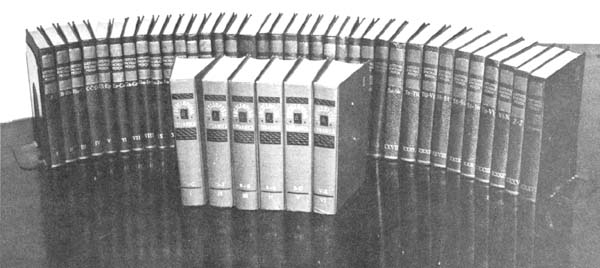
Two Lithuanian Encyclopedias
Several thousand of Lithuanian refugees reached the shores of America after WW II (1949-1952). In the United States, they found about one million of their fellow-compatriots of several generations, who had come here in large waves since the second half of the previous century, alghough even earlier there had been sporadic Lithuanian immigrants.
One of the new arrivals, Juozas Kapočius, had a dream: to publish a multi-volume encyclopedia in Lithuanian. It had to be done in the United States since the Lietuviškoji Enciklopedija ("The Lithuanian Encyclopedia") which had been published since 1933, was not completed (see below). In Soviet-occupied Lithuania, at that time, there were no possibilities. Besides, an encyclopedia published under the Soviet regime means, primarily, a Marxist treatment of many problems, and it cannot be objective, especially in the social sciences, in the humanities, in the liberal arts, etc. (1)
There was another reason: after arriving in various Western countries (i. e., the United States, Canada, Germany, France, Italy, Sweden, England, various South American countries, etc.), it was painful for many Lithuanian scholars and non-scholars alike, to find all kinds of factual mistakes and semi-mistakes in the various reference works available in these countries. Some of these reference works, especially encyclopedias, encyclopedic dictionaries, history and cultural reference books, had some gross errors, others carried some ridiculous distortions of some minor facts. This was, at least partially, due to the lack of specialists in Lithuanian history, literature, linguistics, etc. Quite often, one Western scholar quoted, and in a way perpetuated, some observation, of another non-specialist as the real fact. (2)
As far as a general multi-volume encyclopedia in Lithuanian was concerned, many Lithuanian scholars and people interested in general cultural and scientific information felt that there was a need to have a complete encyclopedia in Lithuanian.
Juozas Kapočius has had much experience as a printer, both in Lithuania, in South America, and then in the United States. Eventually, he settled in Boston, Massachusetts, and began organizing this huge enterprise.
Until 1978, there was a general belief that the first plan to publish an encyclopedia in Lithuanian was initiated by the Lithuanian publisher Antanas Olšauskas about 1909-1910, in Chicago. At that time, he had already found an editor for this venture, but WW I and other difficulties prevented this interesting idea from being realized.
However, as far back as 1883, the Lithuanian journalist Jonas Jacevičius, who at that time lived in Riga, Latvia, had petitioned the Russian Tsarist government for permission to publish various scholarly books in Lithuanian, among them an encyclopedia. (3) Whether Jacevičius' plan could have been carried out, remains unknown since he did not receive the necessary permission.
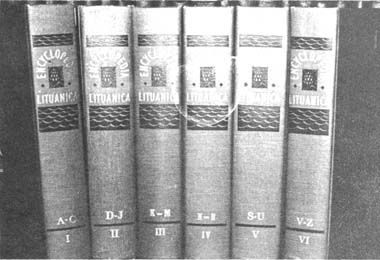
Six Volumes of the Encyclopedia Lituanica.
The first encyclopedia in Lithuanian, as it has been briefly mentioned above, the Lietuviškoji Enciklopedija appeared in 1933, in Kaunas, Lithuania. It was undertaken jointly by the publishing house "Spaudos Fondas" and the Lithuanian Catholic Academy of Sciences. Until WW II, 9 full volumes were completed, and some fascicles of volume 10 (up to letter j).
And now, when in the early fifties, the publisher Juozas Kapočius had started to organize the publication of a general multi-volume encyclopedia in Lithuanian, there were all kinds of opinions expressed in the Lithuanian press published in the West, primarily in the USA and Canada, but, to some degree, also in some European countries and in several countries in South America, especially in Argentina and Brazil where there were large Lithuanian populations.
The eternal pessimists thought that this enterprise will never get off the ground, others opinioned that it will collapse after a volume or two, again others cried that the collapse will come as soon as the letter j will be reached, i. e., the extent of the published Lithuanian Encyclopedia (see above). Other voices wanted to have a shortone volume, or twoencyclopedia dealing only and purely with "things Lithuanian." On the other hand, the major Lithuanian organizations, most of the editorial voices, and a clear majority of the prospective subscribers supported the original plan of Mr. Kapočius, that of a general multi-volume encyclopedia in Lithuanian.
Kapočius stubbornly persevered in his dream: he patiently explained his plan to an inner circle of enthusiasts as well as in the general Lithuanian press. Basically, his plan was such that the moneys received from one volume published would enable him to publish the following volume, etc.
Thus, in the very early fifties, Kapočius organized a permanent editorial staff, bought a printing press, etc. Professor Vaclovas Biržiška became the editor-in-chief. He had also served as editor-in-chief of the Lithuanian Encyclopedia published in Lithuania. (4) Other editors were Antanas Bendorius, Pranas Čepėnas, Juozas Girnius, Vincas Maciūnas, Jonas Puzinas. (The basic expertise of the main editors were as follows: Biržiškabibliography, Bendorius geography, Čepėnashistory, Girniusphilosophy, Maciūnasliterature, Puzinasprehistory). Clearly, from this point of view, the emphasis in this encyclopedia may have been slanted in the direction of social sciences and humanities. However, there was no intention to neglect the strict sciences. Editors for various fields were found, and this encyclopedia, indeed, covers all the sciences, just like any other general encyclopedia in other languages.
In one respect, this Boston-published Lithuanian encyclopedia does differ from many encyclopedias: it has one volume, volume 15, devoted entirely to Lithuania, and things Lithuanian. In fact, this volume fits into the general alphabetical order, but the volume 15 itself is not arranged alphabetically, but topically: geography, area, history, government, economic life, language, etc., etc. A very detailed contents makes it possible to find the necessary information. The editor of this special, and yet "regular" volume was Professor Vincas Maciūnas, a noted literary historian. This volume itself gives the basic and general information on Lithuania.
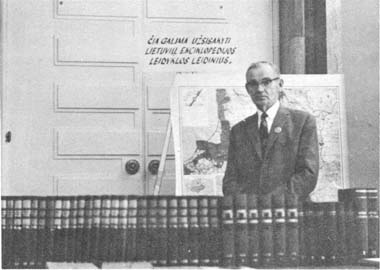
The Publisher: Juozas Kapočius & the two encyclopedias.
All 36 volumes of the Lietuvių Enciklopedija were published between 1953 and 1969. In some years as many as three volumes were published. Volume 36 is a volume of addenda and supplements. It was edited by Juozas Girnius.
The 36 volumes of the Lithuanian Encyclopedia, in Lithuanian, were finished. Each volume has, usually, 544 pages, although the special volume on Lithuania, vol. 15, has 807 pages.
Even before the very end of this great publishing venture which, most probably, has no equal in the history of the publishing enterprises, Juozas Kapočius began thinking about publishing yet another encyclopedia, in English. This special encyclopedia was to deal with Lithuania and everything pertaining to Lithuania and the Lithuanians, including various non-Lithuanian persons who have lived, worked in Lithuania, or contributed something to the Lithuanian affairs in the widest sense. To quote from the Introduction by the editor-in-chief, Professor Sužiedėlis:
The Encyclopedia Lituanica attempts to provide essential information about Lithuania and the Lithuanian nation from the earliest times until the most recent events. For the whole period an account is given of the land, the nation and the state, of major historical events, of social and economic structure and how these changed, of customs, religion and culture, of popular and individual creativity (language, folklore, literature, art, music and other items), of persons and organizations, and of Lithuanian communities abroad. Particular attention is devoted to the period of independent Lithuania, which lasted scarcely twenty years between World Wars I and II. This period was important because conspicuous progress was made in all spheres of life. Since Lithuania became subject to foreign rule again after World War II, the development in the independent life of the country is neglected in Soviet sources of information. This neglect is consciously motivated by a desire to ignore the achievements of independent Lithuania and thereby demonstrate the superiority of the Soviet system.
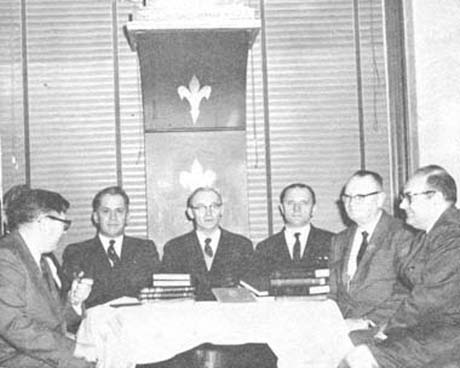
A meeting of the editors of the Lietuvių Enciklopedija: from
l. to r.: Juozas Girnius, Pranas
Čepėnas (behind Girnius), Vincas Maciūnas, Juozas Kapočius (the Publisher), Antanas
Bendorius,
Jonas Puzinas, and Antanas Mažiulis (editorial researcher).

The editorial staff of the Encyclopedia Lituanica: l. to r.: Algirdas Landsbergis, Juozas Jakštas,
Simas Sužiedėlis (Editor-in-chief), Jonas Puzinas, Juozas Kapočius, Vincas Rastenis, Antanas Kučas.
This new encyclopedia, possibly following such famous names as Encyclopedia Britannica, Encyclopedia Americana was destined to be called Encyclopedia Lituanica.
The Encyclopedia Lituanica (EL) is, as we have alluded to above, a special encyclopedia: it deals with all the aspects of Lithuania, the Lithuanians, and the Lithuanian culture and civilization in its widest sense. If, for example, one finds a reference to an American city, it will be as follows: Rochester, Lithuanians of, etc. If it refers to a non-Lithuanian scholar, it will deal, primarily, after giving the basic information about his biographical background, with his contributions having something to do with Lithuanian affairs.
Most of the major articles in the EL were not taken from its "predecessor," the Lietuvių Enciklopedija (further: LE), but were written specially for the EL. Some are completely new, written by different authors. Even when an article was taken, basically, from LE, it was completely re-written, brought up to date, provided with newest bibliography.
Encyclopedia Lituanica was published in six volumes: vol. I (A-C), 1970, 608 pages; vol. II (D-J), 1972, 576 pages; vol. III (K-M), 1973, 576 pages; vol. IV (N-R), 1975, 572 pages; vol. V (S-U), 1976, 574 pages; vol. VI (V-Z); Supplement, Contributors, Index, 1978, 540 pages. One may wonder why an Index was published since most encyclopedias, being arranged strictly alphabetically, do not carry an index. This index, however, will be very helpful to those users who are not specialists of some fields, but want to get acquainted, or to find some primary, initial information in some area. In the Index, the areas are listed alphabetically, and so are the subsequent sub-areas, and, finally, articles themselves. It starts with AGRICULTURE and HUSBANDRY and ends with WARS and BATTLES, and WELFARE. Under each main area, there are subareas, e. g., under LANGUAGE, we will find the following subareas: DIALECTS; LEXICOGRAPHERS; LINGUISTS. It is interesting to note here that there are 111 linguists in this encyclopedia who had done some work in Lithuanian, or Baltic. Thus, the index gives the user a kind of an overview of most areas.
Most of the articles in the EL are short, but there are several dozen articles which have many pages, and really are more than just an encyclopedic summarized information. E. g., the article "Territory of Lithuania" has 33 pages, the article "Vilnius" has 30 pages, etc. There are many illustrations, unfortunately, they are black and white. One has to assume that illustrations in color would have been simply too expensive.
There were many problems, especially those of terminology, in trying to present, in English, some specific areas which do not have an accepted and uniform tradition. E. g., one ancient Baltic tribe, and language, is called in Lithuanian, jotvingiai, or sūduviai. In English, various spellings of these names have been used: Yotvingians, Yatvingians, Suduvians, Sudovians, Sudavians, etc. EL has chosen: Yotvingians and Sudavians. Whether this spelling will set some trend, remains to be seen.
Both encyclopedias comprise 42 rather large volumes, 36 in Lithuanian and 6 in English. Located in the main reference libraries throughout the worldif that were possiblethe Encyclopedia Lituanica would provide enough initial information on practically any research on Lithuania and "things Lithuanian."
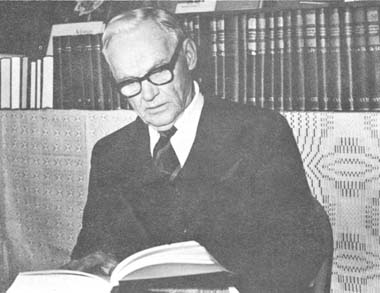
The Dream became reality: the publisher Juozas Kapočius, December, 1979.
If one had the patience to read through the last several volumes of Lituanus, one would certainly notice how many times various authors had been referring both to the general Lietuvių Enciklopedija and the special Encyclopedia Lituanica. (5)
1 Later on, in Soviet-occupied Lithuania, a three-volume "Little Lithuanian Soviet Encyclopedia"
(Mažoji lietuviškoji tarybinė enciklopedija) was published (1966-1971). Since 1975, a multi-volume [most probably 12 volumes] "Lithuanian Soviet Encyclopedia"
(Lietuviškoji tarybinė enciklopedija) is being published. As of this writing [June,
1979] four volumes have appeared.
2 Cf., Julius P. Slavėnas, "The Treatment of Lithuanian History in American Textbooks," Lituanus, vol. 23, No. 3 (Fall, 1977) pp. 41-46.
3 Cf. V. Merkys, Nelegalioji lietuvių spauda kapitalizmo laikotarpiu (ligi
1904 m.), "Mokslas", Vilnius, 1978, p. 151.
4 Prof. Vaclovas Biržiška was the editor-in-chief through volume 3. Later, the other editors edited parts of the encyclopedia, mostly apportioned by (alphabetical) letters.
5 The first two volumes of the EL were reviewed in Lituanus, cf. vol. 19, No. 1 (Spring, 1973), pp. 79-80. (Reviewed by J. A. Račkauskas).